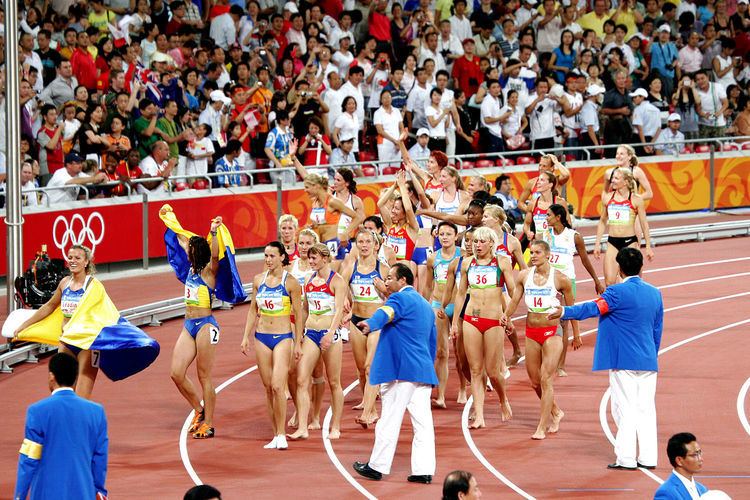 | ||
Olympic Jackie Joyner-Kersee 7291 pts (1988) | ||
A heptathlon is a track and field combined events contest made up of seven events. The name derives from the Greek hepta (seven) and ἄθλος (áthlos, or ἄθλον, áthlon, meaning "feat"). A competitor in a heptathlon is referred to as a heptathlete.
Contents
There are two heptathlons – the women's heptathlon and the men's – composed of different events. The men's heptathlon is older and is held indoors, while the women's is held outdoors and was introduced in the 1980s, first appearing in the Olympics in 1984.
Women's heptathlon
Women's heptathlon is the combined event for women contested in the Athletics program of the Olympics and in the IAAF World Championships in Athletics. The IAAF World Combined Events Challenge determines a yearly women's heptathlon champion. The women's outdoor heptathlon consists of the following events, with the first four contested on the first day, and the remaining three on day two:
The heptathlon has been contested by female athletes since the early 1980s, when it replaced the pentathlon as the primary women's combined event contest (the javelin throw and 800 m were added). It was first contested at the Olympic level in the 1984 Summer Olympics. In recent years some women's decathlon competitions have been conducted, consisting of the same events as the men's competition in a slightly different order, and the IAAF has begun keeping records for it, but the heptathlon remains the championship-level combined event for women. Jessica Ennis-Hill, representing Great Britain, is the 2012 Olympic Gold Medallist and the current World Champion.
There is also a Tetradecathlon, which is a double heptathlon, consisting of 14 events, seven events per day.
Points system
The heptathlon scoring system was devised by Dr Karl Ulbrich, a Viennese mathematician. The formulae are constructed so that, for each event, a designated "standard" performance (for example, approximately 1.82 m for the high jump) scores 1000 points. Each event also has a minimum recordable performance level (e.g. 0.75 m for the high jump), corresponding to zero points. The formulae are devised so that successive constant increments in performance correspond to gradually increasing increments in points awarded.
The events are split into three groups, and the scores are calculated according to the three formulae:
Running events (200 m, 800 m and 100 m hurdles):Jumping events (high jump and long jump):Throwing events (shot put and javelin):P is for points, T is for time in seconds, M is for height or length in centimeters and D is length in meters. a, b and c have different values for each of the events (see table).
Benchmarks
The following table shows the benchmark levels needed to earn 1000, 900, 800 and 700 points in each event.
The other version is an indoor competition, normally contested by men only. It is the men's combined event in the IAAF World Indoor Championships in Athletics. The men's indoor heptathlon consists of the following events, with the first four contested on the first day, and remaining three on day two:
The scoring is similar for both versions. In each event, the athlete scores points for his/her performance in each event according to scoring tables issued by the International Association of Athletics Federations (IAAF). The athlete accumulating the highest number of points wins the competition.
Benchmarks
The following table shows the minimum benchmark levels required to earn 1000 points in each event of the heptathlon:
Women
Notes
The following athletes have had their performances (inside 6702) annulled due to doping offense:
Below is a list of all other scores equal or superior to 6875 pts:
Men
Below is a list of all other scores equal or superior to 6319 pts:
